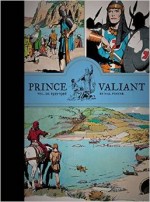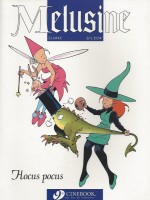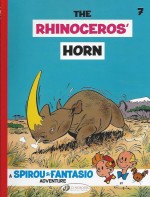
By Hal Foster (Fantagraphics Books)
ISBN: 978-1-60699-800-7
Prince Valiant in the Days of King Arthur launched on Sunday February 13th 1937, a fantastic and fabulous full-colour weekly peek into a world where history met myth to produce something greater than both. Creator Hal Foster had developed the feature after leaving the landmark, groundbreaking, astoundingly popular Tarzan of the Apes strip.
Valiant provided action, adventure, exoticism, romance and plenty of laughs in its engrossing depiction of noble knights and wicked plunderers played out against a glamorised, dramatised Dark Ages backdrop. It followed the life of a refugee boy driven from his ancestral homeland in Scandinavian Thule who grew up to roam the world and attain a paramount position amongst the heroes of fabled Camelot.
Foster wove his epic romance over decades, following the progress of a near-feral wild boy who grew into a paragon of chivalric virtue: knight, warrior, saviour, vengeance-taker and eventually family patriarch in a constant deluge of wild and joyously witty wonderment. The restless hero visited many far-flung lands, siring a dynasty of equally puissant heroes, enchanting generations of readers and thousands of creative types in all the arts.
The strip spawned films, an animated series and all manner of toys, games, books and collections based on Prince Valiant – one of the few adventure strips to have run continuously from the thunderous 1930s to the present day (4000 + episodes and still going strong) – and, even here at the end times of newspaper narrative cartoons as an art form, it continues in more than 300 American papers and via the internet.
Foster crafted the feature alone until 1971 when John Cullen Murphy (Big Ben Bolt) succeeded him as illustrator. Foster continued as writer and designer until 1980, after which he retired and Cullen Murphy’s daughter Mairead took over colouring and lettering whilst her brother John assumed the writer’s role.
In 2004 the senior Cullen Murphy also retired, since when the strip has soldiered on under the auspices of many extremely talented artists such as Gary Gianni, Scott Roberts and latterly Thomas Yeates with Mark Schultz (Xenozoic) scripting.
This latest spellbinding and luxuriously oversized (362 x 264 mm) full-colour hardback collection reprints the pages from January 2nd 1955 to 30th December 1956 (#934-1038) but before we proceed kicks off with an illustration-strewn, memory-stuffed and erudite Introduction from contemporary adventure-strip master Timothy Truman in ‘Schooled by Foster’.
What Has Gone Before: Having brought Christianity to Thule and been instrumental in repulsing an invasion of Saxons and Danes in England whilst his wife Aleta single-handedly dismantled an incipient coup in her homeland of the Misty Isles, Valiant and his family make ready to return to Thule…
The eternal saga picks up as the voyagers encounter a slight problem. An upsurge of piracy makes sea travel all-but impossible and a rising of barbarian hordes from beyond the Danube has cut off overland routes through northern Europe. They are seemingly stranded until Aleta’s Viking handmaiden Katwin offers a solution.
Her father, a great seafaring king, sometimes plied an eastern route to Scandinavia via fabled Constantinople which his men called “the Long Portageâ€â€¦
Soon a brace of well-stocked trade-ships are in the bustling trade capital and Katwin is rounding up Northmen homesick and bold enough to sign up for the risky venture. Before long the assembled crew, Sir Gawain and the astounded royal retinue are approaching Sevastopol on the Crimean coast of the on the Black Sea, readying themselves for the perilous trip up the Dnieper River and overland to the Baltic…
The journey is arduous and made worse when nomadic Ukrainian Patzinaks begin stalking the vessels from the banks of the river. Wary pursuit soon devolves into repeated archery assaults but war-wise Valiant and Gawain quickly devise suitable armoured defences – and even a few land-based counterattacks – and the trek continues.
The cautious progress hits a real snag only after one of the flat-bottomed ships breaks its mid-river mooring whilst Valiant and the majority of the crew are scouting ahead. It floats silently to shore in the dark night and in an instant the vigilant Patzinaks seize their chance.
Rushing the beached boat they capture Aleta – although she is quick enough to hide her children from them. The attending Northmen guards become berserkers and fall upon the Ukrainian raiders but are too late to stop some carrying off the golden-haired queen to their fortress.
By the time Valiant’s party return with the dawn the defenders have buried their dead and are preparing to follow the plunderers. As the enraged Prince leads a column of warriors across the grassy plains, in his dingy city the Great Dragda Khan is finding his glorious new captive far more than he can handle…
Once he is humiliatingly disposed of, Aleta than turns his ambitious lieutenants and potential heirs against each other and by the time her husband arrives to besiege the Patzinak stronghold his job is already half done…
When the Northern reivers finish sacking the city the journey resumes. Valiant wants to avoid any more delays but is convinced by his wife that they should spend time and money in the far more civilised bastion of Kiev where again Aleta’s diplomatic acumen comes into play when the bored and boisterous Vikings begin making trouble.
Departing with a third barge – packed with fabrics, brocades, booty and a flight of dressmakers – the voyage continues.
The pace slows however when the river dwindles and after Valiant is wounded hunting an Aurochs the travellers are forced to hire local natives to guide and even help carry the ships overland to the next navigable section…
Before too long – and after only a few murderous incidents – the boats and goods are hauled through a swamp to another river and the final leg of the voyage can begin. The crew are happy that now they will be going downriver but joy turns to fury when they are attacked by a party of far-travelled Swedish raiders from Gotland.
The already weakened Val almost dies and is relegated to a bed for the remainder of the trip, allowing Foster to reprise and embellish the story of Prince Valiant’s origins and earliest battles (as seen in volume 1 of this series), becoming storyteller to little Arn and his twin baby sisters…
By the time the flashbacks conclude the ships have reached Baltic salt marshes and the ecstatic travellers are preparing to cross the seas to their northern homes. Arn meanwhile has begun his martial training and his doting parents realise with horror that he is going to as headstrong, reckless and worrisome as his sire…
In mid-ocean a tense moment with three Irish raiders ends happily as the Celtic corsairs recognise Valiant from his memorable trip to the Emerald Isle and join him to create a formidable flotilla of seagoing might.
Gawain’s exceedingly homely, inept yet oddly effective servant Pierre experiences a joyous moment when the journey is almost concluded. As he and his master switch ships and divert course for Britain, the bumbler discovers his even dumber brother Jex is a slave at the oars of this new vessel. Before too long the glamorous knight is encumbered with two idiots, not one…
Val and Aleta meanwhile have concluded their arduous ordeal by sailing on to Thule and an exuberant welcome from regal patriarch King Aguar just in time to enjoy the beauty and bounty of a Scandinavian summer.
Seasons turn however and as autumn begins, the northern practice of overturning their ships and stocking up for the long hard winter begins throughout Thule. Ever eager for excitement, Val uses the time to explore inland from the populated coastal region, seeking suitable fields for the populace to cultivate, rather than depend on chancy fishing and raiding to supply their needs in the cold, infertile months.
His expedition is most fruitful as the search yields splendid unused meadows for arable and pastoral farming, lacking only suitable road routes to move people to and crops from them.
Whilst charting the region the party discovers a vast forbidding mountain and Arn falls in love. Amazed and beguiled by the daunting snow-capped peak, the little princeling simply must scale it and nothing his father can say will dissuade him.
Capitulating to the inevitable, Valiant grudgingly allows the escapade, taking some comfort from the fact that his little boy will allow doughty and taciturn Garm the Hunter to accompany him…
Honour and youthful independence upheld, the party returns to the coast and palatial Vikingsholm which is frantically preparing for winter. This soon entails a state visit to the nearby fief of Earl Jon for recreational hunting and bond-building. Even Aleta enjoys the hardy sports and endeavours – at least for the first day.
The second finds her and Katwin staying home to luxuriate in soft pillows and warm baths whilst the menfolk continue to prove their rugged manliness by shooting animals.
Thus the manor is practically defenceless when brutal and scurrilous Northern neighbour Gunnar Freysson and his son Helgi decide that they will supplement their inadequate winter stores by stealing everything the provident Jon has cached away.
If they leave no survivors, who will know that it was friend and not foe who committed the atrocity?
Striking when all the able-bodied men are away, the raiders meet with complete success until they confront Aleta. Taken aback at such a prominent potential victim, Freysson momentarily baulks, allowing the quick-witted queen to craftily light a signal fire.
With no other choice but concealment, the panicked raiders lock Aleta and Katwin in the house and fire it, intending that when the already returning hunting party arrives there will be none to accuse them…
However the rogues have not reckoned on Aleta’s quick wits. She finds a cunning way for them to survive and when Jon, Aguar, Valiant and the warriors storm in to quell the blaze they discover the women scorched but safe. On learning who is responsible they lay their plans for revenge…
As the raiders struggle over frozen mountain passes with their ill-gotten gains, losing many men and much loot to the artic conditions, Valiant and maimed shipwright Gundar Harl concoct a cunning plan. When the exhausted villains finally return to their hall they find their own women and children safely sequestered and vengeful men-at-arms waiting for them…
With Harl now the new lord of Freysson’s fief, the Royal Family return to Vikingsholm for the winter but little Arn is restless and still craves to prove himself. Arguing that the farmland Valiant discovered is useless without a safe route through the mountains, the crafty child campaigns long and forcefully that he be allowed to find one before the snows come…
Sustained pester-power wins out over parental concern and with faithful Garm at his side Arn sets off. What follows is a mesmerising 16-week epic of endurance and bravery to rival the best of Jack London as the old man and the indomitable boy scale mighty peaks only to be trapped in an unseasonably early blizzard. Having found the crucial route, the pair battle against phenomenal hazards with startling grit and ingenuity, and eventually man and boy struggle home to a rapturous welcome…
As winter cloaks the land old friends straggle in as the year turns. Aleta’s former maid Tillicum visits with her son and Viking husband Boltar, as does courtly scoundrel Gawain. All are aware that Arn is of an age when noble sons generally leave home for other houses to begin their long path towards knighthood. Gawain has come to escort Valiant to King Arthur’s annul Grand Tourney in celebration of Pentecost…
During the bombastic spectacle Val befriends a young knight named William Lydney, even accompanying the neophyte to his home in Cornwall as cover for his true mission for Arthur: ferreting out traitors and rumours of sedition in that troubled region…
Young William has the potential to be a great hero but is sorely troubled. He is utterly devoted to and wants to marry his neighbour’s daughter, Gwendolyn of Berkeley. Indeed, she is pledged to the next Lord Vernon but William’s succession to the title is not clear. There is an older brother, who by rights should hold the title, but he has been missing for years and the impatient younger sibling must prove him dead or wait years until he is of age…
The star-crossed love affair descends into tragedy and incredible sacrifice once Valiant and William’s devoted Steward Alfred unpick the mystery and discover a shocking secret. When the drama finally concludes Alfred leaves William’s service to become Valiant’s latest squire
To Be Continued…
Rounding out this gloriously chronicle are two more fascinating features on Foster’s pre-comics career as an advertising artist and the impact of his “Mountie†paintings on early 20th century American ads in the stunning pictorial essay ‘Maintain[ing] the Right [Stuff]: A Gallery of Hal Foster’s Mountie Painting’ and ‘Reclaiming Foster’s Mountie Legacy’ compiled and annotated by Brian M. Kane.
A mind-blowing panorama of visual passion and precision, Prince Valiant is a non-stop rollercoaster of boisterous action, exotic adventure and grand romance; blending epic fantasy with dry wit and broad humour, soap opera melodrama with shatteringly dark violence.
Lush, lavish and captivating lovely, the strip is an indisputable landmark of comics fiction and something no fan should miss.
© 2015 King Features Syndicate. All other content and properties © 2015 their respective creators or holders. This edition © 2015 Fantagraphics Books. All rights reserved.













